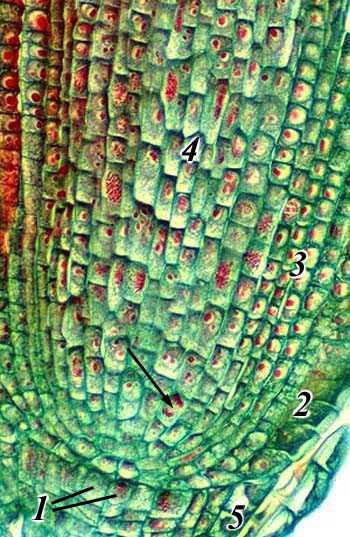Provides the growth of the root in length
No lateral roots are initiated
Planes of cell divisions are ordered, mainly transverse
The growth of the roots in length (the primary growth) as the growth of the shoots is provided by the apical meristems, where cell divisions mostly occur. However, in roots, the small group of cells at the extreme apex, called the quiescent center, divide very infrequently and the highest rate of cell divisions is observed in adjacent tissues of the root tip. The planes of cell division in the root meristem are strictly ordered, and are primarily transverse divisions that provide growth of the root in length. As the result of such ordered divisions, characteristic cell tiers are formed. Typically, the cell initials of the root are vertically tiered into three or four layers of cells. The root apical meristem is covered by the rootcap which provides a protective and lubricative function as growth takes place through soil particles.
Shown here is a median longitudinal section of a grass root tip. Note the clearly defined interface between the root apex proper and the rootcap. Such distinct border is characteristic of grass root apical meristem when the rootcap originates from its own initials, rootcap initials. The quiescent center may be distinguished here as a zone of convergence of cell tiers and a mitotic figure (anaphase, arrow).
In contrast to the shoots, in the roots the initiation of lateral organs does not occur in the apical meristem. Lateral roots arise internally proximally to the apex. They thus arise endogenously, unlike lateral branches in the shoot.
1 = rootcap initials; 2 = protoderm; 3 = ground meristem; 4 = procambium; 5 = rootcap
